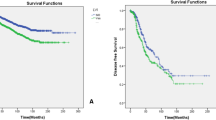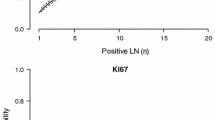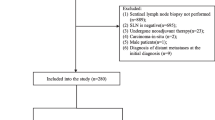Abstract
Background
Extracapsular invasion (ECI) of metastatic axillary lymph nodes has been associated with aggressive nodal disease but its prognostic role in breast cancer is unclear. The present study evaluated nodal ECI as a predictor of breast cancer recurrence.
Methods
We evaluated 154 women with histologically proven node-positive breast cancer who were diagnosed with invasive ductal carcinoma, and investigated the relationships between ECI and recurrences and other clinicopathological factors, particularly vascular invasion and the number of lymph node metastases.
Results
The presence of ECI at positive nodes was significantly associated with the number of positive nodes, and with disease recurrence and survival in univariate (but not multivariate) analysis. Interestingly, all ECI+ patients with distant metastases in our series had peritumoral vascular invasion (PVI), which may have reflected systemic disease; ECI with PVI of the primary tumor strongly predicted recurrent disease and shorter survival.
Conclusion
ECI of axillary metastases combined with PVI indicates high tumor aggressiveness. Patients with ECI and PVI may be considered for stronger adjuvant therapies because of their high risk for distant recurrences.


Similar content being viewed by others
References
Woodward WA, Strom EA, Tucker SL, et al. Changes in the 2003 American Joint Committee on Cancer staging for breast cancer dramatically affect stage-specific survival. J Clin Oncol. 2003;21:3244–48.
Taghian A, Jeong JH, Mamounas E, et al. Patterns of locoregional faiure in patients with operable breast cancer treated by mastectomy and adjuvant chemotherapy with or without tamxifen and without radiotherapy: results from five national Surgical Adjuvant Breast and Bowel Project randomized clinical trials. J Clin Oncol. 2004;22:4247–54.
Hasebe T, Sasaki S, Imoto S, et al. Tumor cells in lymph vessels and lymph nodes closely associated with nodal metastasis by invasive ductal carcinoma of the breast. Cancer Sci. 2003;94:508–14.
Stitzenberg KB, Meyer AA, Stern SL, et al. Extracapsular extension of the sentinel lymph node metastasis: a predictor of nonsentinel node tumor burden. Ann Surg. 2003;237:607–13.
Fujii T, Yanagita Y, Fujisawa T, et al. Implication of extracapsular invasion of sentinel lymph nodes in breast cancer: prediction of non-sentinel lymph node metastasis. World J Surg. 2010;34:544–8.
Achen MG, Stacker SA. Molecular control of lymphatic metastasis. Ann N Y Acad Sci. 2009;1131:225–34.
Royton D, Jackson DJ. Mechanisms of lymphatic metastasis in human colorectal adenocarcinoma. J Pathol. 2009;217:608–19.
Fujii T, Tabe Y, Yajima R, et al. Process of distant lymph node metastasis in colorectal carcinoma of extracapsular invasion of lymph node metastasis. BMC Cancer. 2011;11:216.
D’Journo XB, Avaro JP, Michelet P, et al. Extracapsular lymph node involvement is a negative prognostic factor after neoadjuvant chemoradiotherapy in locally advanced esophageal cancer. J Thorac Oncol. 2009;4:534–9.
Okamoto T, Tsuburaya A, Kameda Y, et al. Prognostic value of extracapsular invasion and fibrotic focus in single lymph node metastasis of gastric cancer. Gastric Cancer. 2008;11:160–7.
Yano H, Saito Y, Kirihara Y, et al. Tumor invasion of lymph node capsules in patients with Dukes C colorectal adenocarcinoma. Dis Colon Rectum. 2006;49:1867–77.
Fujii T, Tabe Y, Yajima R, et al. Extracapsular invasion as a risk factor for disease recurrence in colorectal cancer. World J Gastroenterol. 2011;17:2003–6.
Yamashita H, Noguchi S, Murakami N, et al. Extracapsular invasion of lymph node metastasis. A good indicator disease recurrence and poor prognosis in patients with thyroid microcarcinoma. Cancer. 1999;86:842–9.
Dobi E, Bazan F, Dufresne A, et al. Is extracapsular tumor spread a prognostic factor in patients with early breast cancer? Int J Clin Oncol. 2013;18:607–13.
Leonard C, Corkill M, Tompkin J, et al. Are axillary recurrence and overall survival affected by axillary extranodal tumor extension in breast cancer? J Clin Oncol. 1995;13:47–53.
Bucci JA, Kennedy CW, Burn J, et al. Implications of extranodal spread in node positive breast cancer: a review of survival and local recurrence. Breast. 2001;10:213–9.
Gruber G, Bonetti M, Nasi ML, et al. Prognostic value of extracapsular tumor spread for locoregional control in premenopausal patients with node-positive breast cancer treated with classical cyclophosphamide, methotrexate, and fluorouracil: long-term observations from International Breast Cancer Study Group Trial VI. J Clin Oncol. 2005;23:7089–97.
Gruber G, Cole BF, Castiglione-Gertsch M, et al. Extracapsular tumor spread and the risk of local, axillary and supraclavicular recurrence in node-positive, premenopausal patients with breast cancer. Ann Oncol. 2008;19:1393–1401.
Cserni G. Axillary sentinel lymph node micrometastases with extracapsular extension: a distinct pattern of breast cancer metastasis? J Clin Pathol. 2008;61:115–8.
Stranzl H, Peintinger F, Ofner P, et al. Regional nodal recurrence in the management of breast cancer patients with one to three positive axillary lymph nodes. Outcome of patients following tangential irradiation without a separate nodal field. Strahlenther Onkol. 2004;180:623–8.
Hetelekidis S, Schnitt SJ, Silver B, et al. The significance of extracapsular extension of axillary lymph node metastases in early-stage breast cancer. Int J Radiat Oncol Biol Phys. 2000;46:31–4.
Neri A, Marrelli D, Roviello F, et al. Prognostic value of extracapsular extension of axillary lymph node metastases in T1 to T3 breast cancer. Ann Surg Oncol. 2005; 12:246–53.
Donegan WL, Stine SB, Samter TG, et al. Implications of extracapsular nodal metastases for treatment and prognosis of breast cancer. Cancer. 1993;72:778–82.
Woo CS, Silberman H, Nakamura SK, et al. Lymph node status combined with lymphovascular invasion creates a more powerful tool for predicting outcome in patients with invasive breast cancer. Am J Surg. 2002;184:337–40.
Cornwell LB, McMasters KM, Chagpar AB. The impact of lymphovascular invasion on lymph node status in patients with breast cancer. Am Surg. 2011;77:874–7.
Lauria R, Perrone F, Carlomagno C, et al. The prognostic value of lymphatic and blood vessel invasion in operable breast cancer. Cancer. 1995;76:1772–8.
Acknowledgment
We thank Ms Chizuko Tomioka and Ms Kozue Yoneyama for their assistance in slide preparation.
Discloures
Reina Yajima, Takaaki Fujii, Yasuhiro Yanagita, Tomomi Fujisawa, Takeshi Miyamoto, Tomoko Hirakata, Soichi Tsutsumi, Misa Iijima, and Hiroyuki Kuwano declare that they have no competing financial interests.
Author information
Authors and Affiliations
Corresponding author
Electronic supplementary material
Below is the link to the electronic supplementary material.
Supplement File 1
Examples of scanned H&E staining sections of metastatic breast cancer lymph nodes. Representative ECI– slides; original magnifications: ×40 (a) and ×400 (b). ECI+ slides; original magnifications: ×40 (c) and ×400 (d). Supplementary material 1 (TIFF 439 kb)
Supplement File 2
Time to tumor recurrence determined from Kaplan–Meier curves varies among patients depending on the presence of PVI in positive nodes. Recurrence-free survival curve (A) and breast cancer-specific survival curve (B).Supplementary material 2 (PDF 231 kb)
Rights and permissions
About this article
Cite this article
Yajima, R., Fujii, T., Yanagita, Y. et al. Prognostic Value of Extracapsular Invasion of Axillary Lymph Nodes Combined with Peritumoral Vascular Invasion in Patients with Breast Cancer. Ann Surg Oncol 22, 52–58 (2015). https://doi.org/10.1245/s10434-014-3941-x
Received:
Published:
Issue Date:
DOI: https://doi.org/10.1245/s10434-014-3941-x




